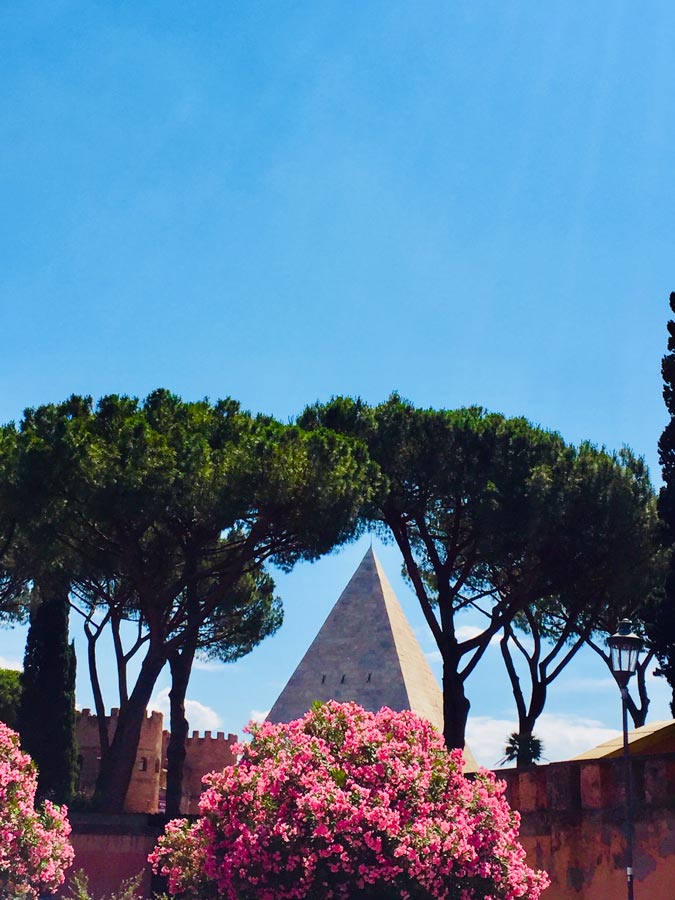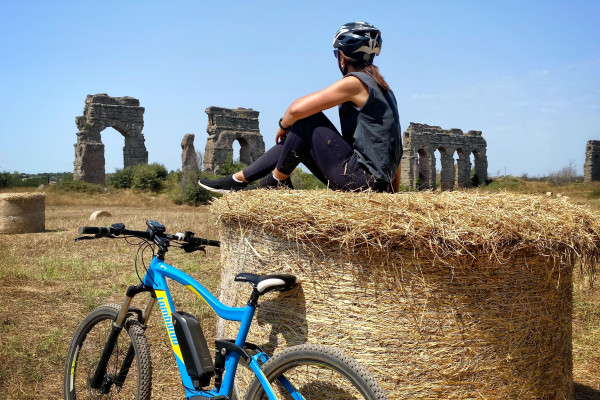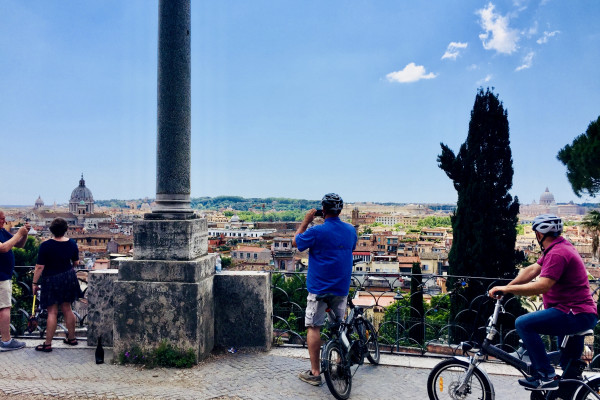10 unusual things to do in Rome

Discover with us the 10 unusual things to see in Rome off the usual beaten paths!
What to do on an e-bike tour in Rome?
Rome, a real open-air museum, known all over the world for its cultural influence through its history, art and beauty.
Its historic center is full of monuments and emblematic viewpoints, but the Eternal City is not limited to the essential …
In fact, it also contains many unusual or lesser known places that are just as important and that add to the singularity of the capital.
Here we suggest 10 sites not to be missed if you want to discover Rome in a different way…
I – Il Giardino degli Aranci
“Il Giardino degli Aranci”, whose real name is “Parc Savello”, stands on the Aventine hill and was built in 1932 on a project by the architect Raffaele De Vico. It is located between the ancient walls of the Savelli fortress built towards the end of the 13th century.
This park will amaze you thanks to the belvedere it offers over the city, in front of the dome of St. Peter’s Basilica, with the Janiculum, and under the Tiber. The “Jardin des Orangers” is one of the most popular places for its calm, its view, the various musicians who come to enchant us with their romantic melodies …
In short, a real place where magic and sweetness meet.

II – The keyhole of the place of the Order of the Knights of Malta
Once you are in front of the huge door you can lean out and look through the “keyhole” … and the view you will discover is simply unusual and splendid. In an alley of the inner garden of the Priory, at the end of a tunnel of hedges, you will see the dome of St. Peter’s Basilica and this sight will surely leave you speechless.
This door and this lock belong to the Villa of the Order of Malta which, together with the square, were set up by Giovanni Battista Piranesi on the orders of Cardinal Giovanni Battista Rezzonico in the 18th century. This building houses the Order’s Embassy to the Italian Republic, the Embassy to the Holy See and the headquarters of the Grand Priory of Malta.

III – The Gianicolo’s Cannon
If you go to the Gianicolo to admire its famous view of the city, remember to go there for noon, you will witness a unique show of its kind!
A tradition that is repeated every day, with rain or shine, and which can be observed from one of the most beautiful viewpoints in the city. This is the blank cannon shot fired from the Gianicolo at exactly noon, a rite that began on 1 December 1847. It was Pope Pius IX who introduced it, to have a single signal of the time and synchronize the sound of church bells with this event. During the Second World War the cannon was silenced for reasons of public order and replaced by the sound of a siren.
It was only in 1959 that the tradition was restored: on April 21 of that year, on the occasion of the 2712th anniversary of the founding of Rome, the cannon thundered again.

IV – The Non-Catholic Cemetery of Rome (Testaccio district)
Also known in Rome as “Cemetery of the Protestants”, or “Cemetery of the English”, or “Cemetery of Artists and Poets”, it is a burial place where art, beauty and nature come together to make it splendid and unique. Once inside, the cypresses, the flowers, the vegetation around the tombs (some are real works of art), the Pyramid, the Aurelian Walls and the lying cats will make you fall in love with this unusual place full of emotions. Several artists are buried there, such as the English poets Percy Bysshe Shelley (1792-1822) and John Keats (1795-1821).
The Non-Catholic Cemetery in Rome dates back to at least 1716 according to documents that record the permission granted by Pope Clement XI, to the members of the Stuart Court in exile from England, to be buried in front of the pyramid. Then the permit was extended to other non-Catholic people. The population of the Non-Catholic Cemetery is extremely varied and about 4000 people of all religions and nationalities rest in this place.

V – The Pyramid of Cestia (Testaccio district)
Outside Porte San Paolo and inside the non-Catholic cemetery of Rome is the incredible Pyramid of Cestia, you cannot miss this unusual and important Egyptian-style monument in the heart of the Eternal City.
It is the tomb of the praetor (magistrate of ancient Rome) Gaius Cestius and was built from 18 to 12 B.C. It is a spectacular sepulchral building 29.50 m high. side for 36.40 m in height, completely covered with marble slabs; its particular shape is the expression of this “Egyptian fashion” which spread to Rome after the conquest of Egypt in 30 B.C.

VI – The water clock in the park of Villa Borghese
During a walk in the Villa Borghese Park, towards the Pincio terrace which will offer you a magnificent view of the city of Rome, you will pass along the famous water clock. The water clock (or Idrocronometro) was made in 1867 by Giovanni Battista Embriaco, a Dominican brother who was passionate about watches and engineering.
This clock has been located in the Villa Borghese Park since 1873. The clock works thanks to the presence of water that falls from above and fills two elongated basins in the shape of small leaves (similar to two pots of a scale), balanced on a pivot.

VII – Coppedè district
Coppedè is one of the most characteristic districts of the city and it is located in the heart of Rome, a few steps from the historic center. It stands out for its singularity and it is not strictly speaking a neighborhood but rather a small complex of buildings with unusual and bizarre shapes, a fantastic blend of Art Nouveau with inspirations from Greek, Gothic, Baroque and even medieval art.
It is a set of 26 buildings and 17 villas that stands between the Via Salaria and Nomentana streets.
A large richly decorated arch that unites the two palaces of the ambassadors and from which hangs a large and superb wrought iron lamppost, marking the entrance to the district completed between 1913 and 1926, by the eclectic architect Gino Coppedè (1866-1927), from which the district takes the name.
VIII – The Church of Sant’Ignazio di Loyola
As you walk towards the Pantheon, be sure to pass by the “Place Sant’Ignazio” built in Rococo style by Filippo Raguzzini in 1727 and 1728. It is in this picturesque place that the majestic Baroque church of Saint-Ignatius of Loyola stands. Dedicated to Saint Ignatius of Loyola, founder of the Society of Jesus.
Andrea Pozzo (architect, painter and decorator 1642-1709), painted a splendid fresco depicting “The entrance into Paradise of Saint Ignatius”. It is necessary to position yourself in the marble circle on the easternmost floor to better appreciate the perspectives.
Also by Andrea Pozzo, the very lucky trompe-l’oeil of a false dome, this painting was made in place of a dome because the neighboring sisters did not want it for fear that it would cast too much shade onto their garden. Other sources rather indicate a lack of funds to build this dome.
IX – The Ancient Pharmacy of Santa Maria della Scala
Walking through the picturesque “Trastevere” district you can discover the oldest pharmacy in Rome, by booking a visit.
Born in the sixteenth century, for the internal use of the convent annexed to the church of the same name and open to the public by the end of the following century, the grocery store of Santa Maria della Scala is the oldest pharmacy in Rome and in Europe, a small jewel of the Trastevere district.
It was the Discalced Carmelite Order that ran it and sold its medicines until 1954, when the grocery store closed. Thanks to its strategic position and its proximity to Saint-Pierre, the pharmacy has become so important over time because it is frequented by cardinals, princes and even by popes, this is why it obtained the name of “Pharmacy of the Popes”.
X – The Capuccini Crypt of Santa Maria della Concezione
If you want to discover Rome in an original, unusual or even gloomy way, we recommend that you discover the Capuccini Crypt. In fact, you can be involved in an atmosphere that is at least dark, even scary but particularly interesting.
The Church of Santa Maria della Concezione was therefore initially just a simple church, a Capuccini convent, a relatively poor order.
The crypt was built between 1626 and 1631 on the instruction of Pope Urban VIII, because his brother Antonio Barberini was a Capuccino. As a cardinal, Barberini made the remains of thousands of Capuccini unearthed in the monastery in via dei Lucchesi and placed their bones as a kind of works of art and symbols along the walls of the crypt. Six rooms were decorated from the 17th century onwards by the Capuccini with the bones of their deceased brothers. On the walls hang whole skeletons or human skeletal remains, and sometimes even the skulls.
The crypt houses the remains of the bodies of about 3600 monks buried between 1500 and 1870.
To see all these amazing places book the Hidden Rome Experience Tour.
Book With Extra Flexibility
Choose new departure dates if your plans change.
Reach out to us anytime via online chat, phone or email.
Get credit for future trips if you need more time to decide.
Change to a different tour run by the same tour operator.







